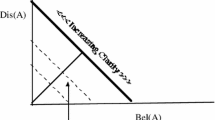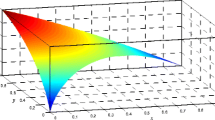Abstract
After discussing the basics of belief structures we introduce a new class of belief structures in which we select from among the focal elements using a possibility measure. We refer to this as a maxitive belief structure, MBS. The concepts of belief and plausibility are defined for an MBS, and it is noted how an MBS can be used to model imprecise possibility distributions. We describe various operations with these structures including arithmetic and fusion. We look at the use of the Choquet integral type aggregation for these MBS. Measures other than belief and plausibility were defined for these structures.
Similar content being viewed by others
References
Beliakov G, Pradera A, Calvo T (2007) Aggregation functions: a guide for practitioners. Springer, Heidelberg
Caselton WF, Luo W (1992) Decision making with imprecise probabilities: Dempster–Shafer theory and application. Water Resour Res 28:3071–3083
Choquet G (1953) Theory of capacities. Annales de l’Institut Fourier 5:131–295
Dammak F, Baccour L, Alimi A (2016) An exhaustive study of possibility measures of interval-valued intuitionistic fuzzy sets and application to multicriteria decision making. Adv Fuzzy Syst 2016:9185706. https://doi.org/10.1155/2016/9185706
Dempster AP (1968) A generalization of Bayesian inference. J R Stat Soc 30:205–247
Dempster AP (1966) New methods of reasoning toward posterior distributions based on sample data. Ann Math Stat 37:355–374
Dempster AP (1967) Upper and lower probabilities induced by a multi-valued mapping. Ann Math Stat 38:325–339
Dempster AP (2008) The Dempster–Shafer calculus for statisticians. Int J Approx Reason 48:365–377
Dubois D, Prade H, Rico A (2013) Qualitative capacities as imprecise possibilities. In: van der Gaag LC (ed) Symbolic and quantitative approaches to reasoning with uncertainty. ECSQARU 2013. Lecture Notes in Computer Science, vol 7958. Springer, Berlin, pp 169–180
Fu C, Yang SL (2011) Analyzing the applicability of Dempster’s rule to the combination of interval-valued belief structures. Expert Syst Appl 38:4291–4301
Klement EP, Mesiar R, Pap E (2010) A universal integral as common frame for Choquet and Sugeno. IEEE Trans Fuzzy Syst 18:178–187
Klir GJ (2006) Uncertainty and information. Wiley, New York
Klir GJ, Wierman MJ (1999) Uncertainty based information. Springer, Heidelberg
Liu L, Yager RR (2008) Classic works of the Dempster–Shafer theory of belief functions: an introduction. In: Yager RR, Liu L (eds) Classic works of the Dempster–Shafer theory of belief functions. Springer, Heidelberg, pp 1–34
Moore RE (1966) Interval analysis. Prentice-Hall, Englewood Cliff
O’Hagan M (1990) Using maximum entropy-ordered weighted averaging to construct a fuzzy neuron. In: Proceedings 24th annual IEEE Asilomar conference on signals, systems and computers, Pacific Grove, CA, pp 618–623
Shafer G (1976) A mathematical theory of evidence. Princeton University Press, Princeton
Smets P (1988) Belief functions. In: Smets P, Mamdani EH, Dubois D, Prade H (eds) Non-standard logics for automated reasoning. Academic Press, London, pp 253–277
Smets P (1992) The tranferable belief model and random sets. Int J Intell Syst 7:37–46
Smets P, Kennes R (1994) The transferable belief model. Artif Intell 66:191–234
Sugeno M (1977) Fuzzy measures and fuzzy integrals: a survey. In: Gupta MM, Saridis GN, Gaines BR (eds) Fuzzy automata and decision process. North-Holland, Amsterdam, pp 89–102
Tsiporkova E, De Baets B (1998) A general framework for upper and lower possibilities and necessities. Int J Uncertain Fuzziness Knowl Based Syst 6:1–34
Wang Z, Klir GJ (2009) Generalized measure theory. Springer, New York
Yager RR, Liu L, (Dempster AP, Shafer G, Advisory Editors) (2008) Classic works of the Dempster–Shafer theory of belief functions. Springer, Heidelberg
Yager RR (1987) On the Dempster–Shafer framework and new combination rules. Inf Sci 41:93–137
Yager RR (1996) Quantifier guided aggregation using OWA operators. Int J Intell Syst 11:49–73
Yager RR (2017) Belief structures, weight generating functions and decision-making. Fuzzy Optim Decis Mak 16:1–21
Yager RR, Kacprzyk J, Fedrizzi M (1994) Advances in the Dempster–Shafer theory of evidence. Wiley, New York
Zadeh LA (1978) Fuzzy sets as a basis for a theory of possibility. Fuzzy Sets Syst 1:3–28
Zadeh LA (1979) Fuzzy sets and information granularity. In: Gupta MM, Ragade RK, Yager RR (eds) Advances in fuzzy set theory and applications. North-Holland, Amsterdam, pp 3–18
Zadeh LA (1979) On the validity of Dempster’s rule of combination of evidence, Memo# UCB/ERL, M79/32. University of California, Berkeley
Author information
Authors and Affiliations
Corresponding author
Ethics declarations
Conflicts of interest
The author declare that he has no conflict of interest.
Additional information
Communicated by A. Di Nola.
Rights and permissions
About this article
Cite this article
Yager, R.R. A class of belief structures based on possibility measures. Soft Comput 22, 7909–7917 (2018). https://doi.org/10.1007/s00500-018-3062-8
Published:
Issue Date:
DOI: https://doi.org/10.1007/s00500-018-3062-8




